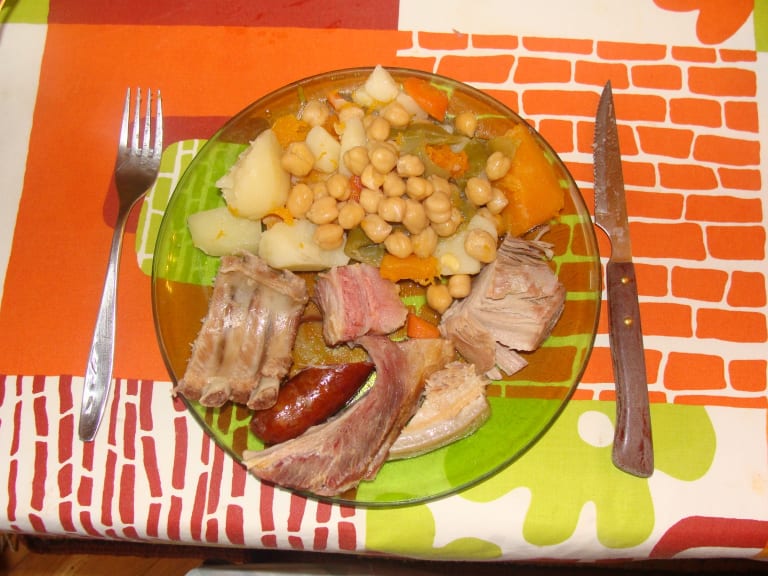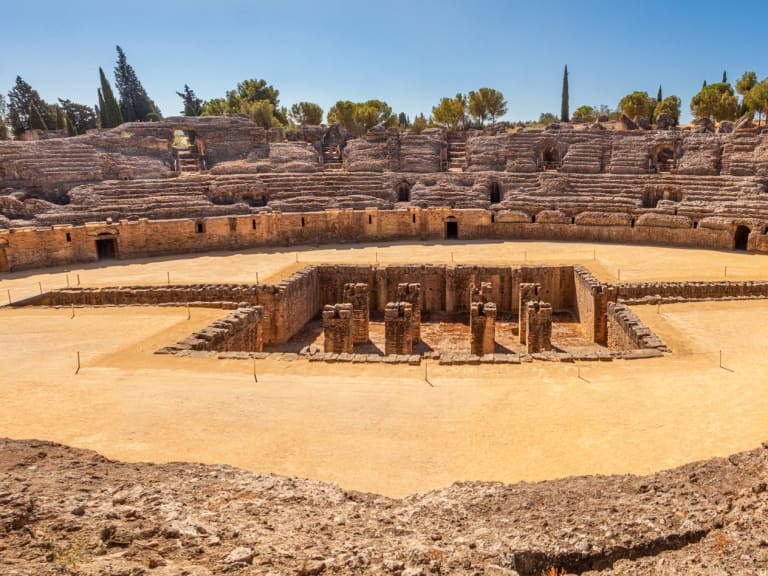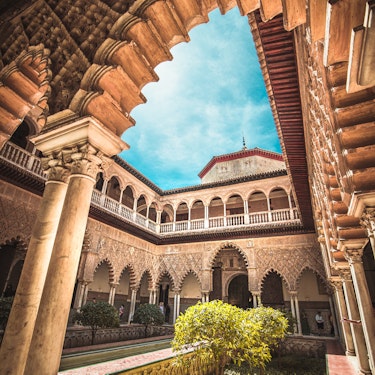More about: 10 Things to Do in Seville in Winter
There are no better times to visit a city than others. Each season has its advantages and its public. For example, winter is the ideal season for those who want to get to know all that Seville has to offer while escaping the heat and the crowds. A season where the cold is not an impediment and in which there is no shortage of plans and ideas to get to know another side of the Andalusian city.
In the winter months there are also festivals and events that are celebrated with special enthusiasm in the city, as well as, of course, its best monuments and traditional places seen from the perspective of the calm that characterises the winter in Seville.
1. Seville's Cathedral and Alcázar must-see with fewer tourists than at other times of the year

Visiting Seville Cathedral and the Alcazar is the first thing you should do when you arrive in the city. Although it sounds like a typical plan and it can be done all year round, the truth is that seeing this monumental complex in winter has a great advantage. There are far fewer people than during the rest of the year.
If you book your tickets for Seville Cathedral or the Alcazar in advance, you will be able to see all the wonders of these places without queuing up. Keep in mind that both monuments receive more than 2 million visitors a year.
Seville Cathedral is not just any cathedral, but the largest Gothic cathedral in the world, and the Alcazar is the oldest active royal residence in Europe. In addition, both monuments are World Heritage Sites.
2. January is the fashionable month for Flamenco

Flamenco lovers travelling to Seville in January will find a date marked in red on the calendar. In the first month of the year, We Love Flamenco has been held for more than a decade, an event focused on flamenco fashion where the best artisans and manufacturers bring out the best dresses for the catwalks that are held in different parts of the city.
This event serves as a preparation for the famous April fair and taking advantage of the occasion there are also special flamenco shows and performances with the Triana neighbourhood, as usual, being the stage and cradle of this characteristic musical genre.
Whether you like fashion or music, this event is the best attraction in winter.
3. Take a gastronomic tour to warm you up

Gastronomy is one of Seville's strong points and never better said. It is true that winter is not particularly cold in the city, but the humidity of the Guadalquivir and the occasional cold day mean that eating good hot dishes is very much appreciated.
And for this we can take a gastronomic tour of the city and try some of its winter delicacies:
- Andalusian stew, similar to cocido madrileño but with certain particularities.
- Eggs "a la flamenca", a dish with fried eggs as the main ingredient, usually served with a base of fried tomato and some vegetables or sausages on a hot plate.
- Roasted chestnuts, which are sold in street stalls.
- Churros with chocolate for breakfast.
- Oxtail stew, a winter delicacy.
4. Take shelter from the cold in its museums

Whenever you visit a European city in winter , it is always a good idea to have a plan in case you get caught on a cold day or days. In these cases I usually recommend visiting museums if the city in question has an interesting range of museums. And, fortunately, this is the case in Seville. There are several museums in Seville, some of which have unique themes.
This is the case of the Flamenco Dance Museum, unique in its subject matter and one of the most important in the city. It is located in the Santa Cruz neighbourhood, between the Plaza de la Alfalfa and the Cathedral, and also has a performance hall where concerts are held regularly. You have more information in this post.
Other alternatives are the Museum of Fine Arts in the Plaza del Museo, or the Maritime Museum, which is located in the famous Torre del Oro. All of them are excellent places to visit on cold days.
5. Join in the Andalusia Day activities.

28 February is a very special date for the city of Seville and for Andalusia. It is one of the most special days to visit the capital of Andalusia as the city is decorated and prepared to host numerous activities and events.
The museums and archaeological sites play a leading role among the activities on this day. Booking an excursion to Italica from Seville is an excellent idea, as theatre performances are staged in the ruins of this ancient Roman city on this day.
Apart from the official programme of activities, this is a date that I highly recommend for getting fully immersed in Sevillian customs. This includes, for example, taking a boat trip on the Guadalquivir, booking a tapas and flamenco tour of Seville or visiting the most emblematic places in Seville on a private tour Any excuse is a good one to soak up the Sevillian spirit, but on Andalusia Day it's even easier.
6. Experience Christmas in Seville

In any European city, Christmas is the main event of the winter. Seville is no exception. These festivities are celebrated in Seville with great enthusiasm and a great deal of tradition. Christmas markets, street lighting, Christmas sweets and carol singing competitions are the classics of Christmas in Seville.
One of Seville's favourite plans is to follow the famous route of the nativity scenes. An itinerary through the city's churches that set up their own nativity scenes with an exquisite level of craftsmanship. In any case, if you want to find out all that Christmas in Seville has to offer, you can do so by following this link.
And if you want to admire the Christmas lights that decorate the capital of Seville, there is nothing better than booking a seat on the tourist bus, from which you will be able to contemplate the most representative monuments of Seville decorated for Christmas in a comfortable and warm way.
7. Celebrate Immaculate Conception Day

Religious festivals are experienced with special enthusiasm in Seville. Proof of this is its famous Holy Week. But this is not the only date marked on the calendar in this respect. Another very special day for the city is 8 December, when the day of the Immaculate Conception is celebrated. A date that has many activities and traditions linked to it.
The dance of the Seises is a traditional dance performed by a group of children in Seville Cathedral, which can be enjoyed free of charge from 8 December until 15 December.
There are also special celebrations in the Cathedral and even the university tunas play in several of the city's central squares. But the highlight is undoubtedly the procession that takes the virgin through the streets of Seville and always attracts thousands of tourists.
8. Sporting season in the Andalusian city

Given that winter temperatures in Seville are very mild and in spring and summer they are very high, this is a time of the year that is ideal for outdoor sports. In fact, there are several important events during these months, such as the half marathon and the Seville marathon.
The Seville half marathon serves as an appetizer for the full marathon. It is held at the end of January and has both the full 21 kilometre variant and a shorter 10 kilometre variant. Both circuits pass through some of the most emblematic places in the city.
A few days later, in February, the main event, the marathon, is held. It is twice as long and has twice the international recognition.
9. Enjoy the carnivals

One of the most celebrated festivals in winter are the carnivals. In Andalusia, those of Cadiz are the most famous and world-renowned, but those of Seville are also worthwhile, especially because they share many things with those of the city of Cadiz.
In fact, some of the groups and chirigotas from Cádiz travel to Seville after the Carnival of Cádiz. Some of these groups join the festivities in neighbourhoods such as Triana or in towns near Seville, such as Carmona.
In the city of Seville, a festival is held in early to mid-March in which the groups and chirigotas perform several shows with the characteristic Andalusian humour as the predominant feature. This festival is held at the Cartuja Centre Cite in Seville. A very fun plan for the winter in Seville.
10. Have a great time in a winter theme park: Sevilla On Ice.

With the arrival of winter and Christmas, a winter theme park is set up in Seville, Sevilla On Ice, a park that is installed every winter in the Muelle de las Delicias, next to the Guadalquivir, and which is the best place to enjoy the winter, especially if you are travelling to Seville with children.
The park has the largest outdoor ice rink in Spain as its main attraction, accompanied by a dozen attractions such as an ice slide, ferris wheels, bouncy castles, etc.
There are also gastronomic areas and all kinds of entertainment to have a great time despite the cold weather. The park is generally open from the end of November to mid-January.
Temperatures in Seville in winter

If you're looking for a European city to visit in winter where the cold is not a problem, Seville is one of the warmest cities on the continent.
The average temperature is around 12 degrees Celsius with highs of over 15 degrees Celsius and lows that rarely drop below 5 or 6 degrees Celsius. January is the coldest of the winter months, but not much colder than this.
In addition to being a mild winter, the advantage is that rainfall is rare. Despite being the rainiest time of the year, on average there are no more than 5 or 6 rains per month. If there is a downside, it would be the humidity of the Guadalquivir, which can sometimes make the thermal sensation colder. But, as you can see, Seville is the ideal destination for the coldest of the cold.
The influx of tourists and prices in Seville in winter

This section represents another of the great advantages of visiting Seville in winter. This is the time of year when there are fewer tourists in the city and, therefore, when there are fewer crowds and it is more comfortable to visit the monuments.
Finding accommodation during these months is fairly easy. The only upturn is at Christmas, when people take advantage of the holidays to see the city all decked out.
Prices also drop considerably due to the low demand. It's not an overly expensive city, but if you're looking to save on your trip it's best to choose months like February. In any case, Seville in winter is very appealing to see. Away from the heat, the crowds and with lower prices.
What to pack in your suitcase to visit Seville in winter

Another advantage of travelling to Seville in winter is when it comes to packing your suitcase. Normally if we travel to a European city in winter, space is usually a problem due to the amount of warm clothes we have to pack. This is not the case.
To travel to Seville it is enough to take a light coat and light winter clothes such as jumpers. Although it doesn't usually rain, a mackintosh is never a bad idea, and the most important thing is to wear comfortable shoes to walk around the city, as it is very easy to visit on foot.




